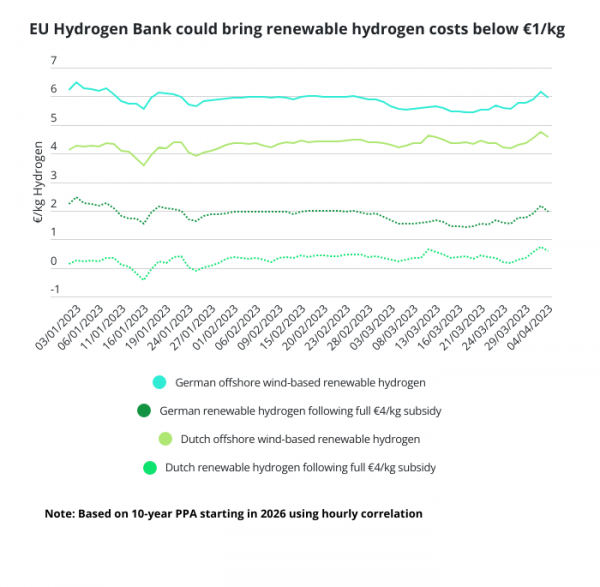- English
- Español
- Português
- русский
- Français
- 日本語
- Deutsch
- tiếng Việt
- Italiano
- Nederlands
- ภาษาไทย
- Polski
- 한국어
- Svenska
- magyar
- Malay
- বাংলা ভাষার
- Dansk
- Suomi
- हिन्दी
- Pilipino
- Türkçe
- Gaeilge
- العربية
- Indonesia
- Norsk
- تمل
- český
- ελληνικά
- український
- Javanese
- فارسی
- தமிழ்
- తెలుగు
- नेपाली
- Burmese
- български
- ລາວ
- Latine
- Қазақша
- Euskal
- Azərbaycan
- Slovenský jazyk
- Македонски
- Lietuvos
- Eesti Keel
- Română
- Slovenski
- मराठी
- Srpski језик
Below 1 euro per kilo! The European Hydrogen Bank wants to slash the cost of renewable hydrogen
2023-04-10
According to the report on Future Trends of Hydrogen Energy released by the International Hydrogen Energy Commission, global demand for hydrogen energy will increase tenfold by 2050 and reach 520 million tons by 2070. Of course, the demand for hydrogen energy in any industry involves the whole industrial chain, including hydrogen production, storage and transportation, hydrogen trading, hydrogen distribution and use. According to the International Committee on Hydrogen Energy, the output value of the global hydrogen industry chain will exceed 2.5 trillion US dollars by 2050.
Based on the huge usage scenario of hydrogen energy and the huge industrial chain value, the development and utilization of hydrogen energy has not only become an important path for many countries to achieve energy transformation, but also become an important part of international competition.
According to preliminary statistics, 42 countries and regions have issued hydrogen energy policies, and 36 countries and regions are preparing hydrogen energy policies.
In the global hydrogen energy competition market, emerging market countries are simultaneously targeting green hydrogen industry. For example, the Indian government allocated 2.3 billion US dollars to support the green hydrogen industry, Saudi Arabia's super future city project NEOM aims to build a hydropower hydrolysis hydrogen production plant with more than 2 gigawatts in its territory, and the United Arab Emirates plans to spend 400 billion US dollars annually in five years to expand the green hydrogen market. Brazil and Chile in South America and Egypt and Namibia in Africa have also announced plans to invest in green hydrogen. As a result, the International Energy Organization predicts that global green hydrogen production will reach 36,000 tons by 2030 and 320 million tons by 2050.
The hydrogen energy development in developed countries is even more ambitious and puts forward higher requirements on the cost of hydrogen use. According to the National Clean Hydrogen Energy Strategy and Roadmap issued by the US Department of Energy, the domestic hydrogen demand in the US will rise to 10 million tons, 20 million tons and 50 million tons per year respectively in 2030, 2040 and 2050. Meanwhile, the cost of hydrogen production will be reduced to $2 per kg by 2030 and $1 per kg by 2035. South Korea's Law on Promoting Hydrogen Economy and Hydrogen Safety Management also puts forward the goal of replacing imported crude oil with imported hydrogen by 2050. Japan will revise its basic hydrogen energy strategy at the end of May to expand the import of hydrogen energy, and stressed the need to accelerate investment in building an international supply chain.
Europe is also making continuous moves on hydrogen energy. The EU Repower EU plan proposes to achieve the goal of producing and importing 10 million tons of renewable hydrogen per year by 2030. To this end, the EU will provide financing support for hydrogen energy through several projects such as the European Hydrogen Bank and the Investment Europe Plan.
London - Renewable Hydrogen is able to be sold for less than 1 euro/kg under Bank terms published by the European Commission on March 31 if producers receive maximum support from the European Hydrogen Bank, ICIS data showed.
The bank, which was announced in September 2022, aims to support hydrogen producers through an auction bidding system that ranks bidders based on the price per kilogram of hydrogen.
Using the Innovation Fund, the Commission will allocate €800m for the first auction to receive support from the European Development Bank, with subsidies capped at €4 per kilogram. The hydrogen to be auctioned must comply with the Renewable Fuels Authorization Act (RFNBO), also known as Renewable Hydrogen, and the project must reach full capacity within three and a half years of receiving funding. Once hydrogen production starts, money will be available.
The winning bidder will then receive a fixed amount, based on the number of bids, for ten years. Bidders cannot have access to more than 33% of the available budget and must have a project size of at least 5MW.

€1 per kilogram of hydrogen
The Netherlands will produce renewable hydrogen from 2026 using a 10-year renewable energy Purchase agreement (PPA) at a cost of 4.58 euros/kg on a project break-even basis, according to ICIS's April 4 assessment data. For the 10-year PPA renewable hydrogen, ICIS calculated the recovery of the cost investment in the electrolyzer during the PPA period, which means that the cost will be recovered at the end of the subsidy period.
Given that hydrogen producers can receive a full subsidy of €4 per kg, this means that only €0.58 per kg of hydrogen is needed to achieve capital cost recovery. Producers then need only charge buyers less than 1 euro per kilogram to ensure the project breaks even.





